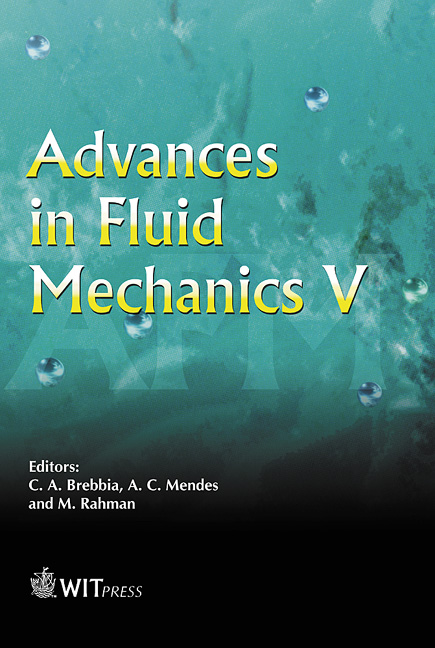Secondary Instabilities In Shock-induced
Transition To Turbulence
Author(s)
P. Vorobieff, C. Tomkins, S. Kumar, C. Goodenough,
N.G. Mohamed & R.F. Benjamin
Abstract
Richtmyer-Meshkov instability (RMI) occurs wherever a density gradient is impulsively
accelerated, e.g., by a shock wave. Misalignment between pressure and density
gradients leads to baroclinic production of vorticity, the latter resulting in formation
of vortical structures after the shock wave passage. The vortex-dominated
evolution of the flow eventually leads to turbulence. In the process of RMI-induced
transition to turbulence, several secondary instabilities could develop in the flow,
driven, e.g., by shear (Kelvin-Helmholtz) or by density-pressure gradient misalignment
(secondary baroclinic instability). The exact nature of the secondary
instabilities has been the subject of some discussion in the lite
Keywords
Related Book
Other papers in this volume
Warning (2)
: foreach() argument must be of type array|object, null given [in
/var/www/dce7ae55-385b-4ffa-8595-3ec5e61ff110/public_html/app/templates/Papers/view.php, line
364]
Code
$counter = '0';
foreach ($paper['book']['Paper'] as $otherPaper) {
if ((!empty($otherPaper['name'])) && ($counter < '7') && ($otherPaper['available'] == 1)) {
Cake\Error\ErrorTrap->handleError() /var/www/dce7ae55-385b-4ffa-8595-3ec5e61ff110/public_html/app/templates/Papers/view.php, line 364
/var/www/dce7ae55-385b-4ffa-8595-3ec5e61ff110/public_html/app/vendor/cakephp/cakephp/src/View/View.php /var/www/dce7ae55-385b-4ffa-8595-3ec5e61ff110/public_html/app/vendor/cakephp/cakephp/src/View/View.php, line 1188
Cake\View\View->_evaluate() /var/www/dce7ae55-385b-4ffa-8595-3ec5e61ff110/public_html/app/vendor/cakephp/cakephp/src/View/View.php, line 1145
Cake\View\View->_render() /var/www/dce7ae55-385b-4ffa-8595-3ec5e61ff110/public_html/app/vendor/cakephp/cakephp/src/View/View.php, line 785
Cake\View\View->render() /var/www/dce7ae55-385b-4ffa-8595-3ec5e61ff110/public_html/app/vendor/cakephp/cakephp/src/Controller/Controller.php, line 712
Cake\Controller\Controller->render() /var/www/dce7ae55-385b-4ffa-8595-3ec5e61ff110/public_html/app/vendor/cakephp/cakephp/src/Controller/Controller.php, line 516
Cake\Controller\Controller->invokeAction() /var/www/dce7ae55-385b-4ffa-8595-3ec5e61ff110/public_html/app/vendor/cakephp/cakephp/src/Controller/ControllerFactory.php, line 166
Cake\Controller\ControllerFactory->handle() /var/www/dce7ae55-385b-4ffa-8595-3ec5e61ff110/public_html/app/vendor/cakephp/cakephp/src/Controller/ControllerFactory.php, line 141
Cake\Controller\ControllerFactory->invoke() /var/www/dce7ae55-385b-4ffa-8595-3ec5e61ff110/public_html/app/vendor/cakephp/cakephp/src/Http/BaseApplication.php, line 362
Cake\Http\BaseApplication->handle() /var/www/dce7ae55-385b-4ffa-8595-3ec5e61ff110/public_html/app/vendor/cakephp/cakephp/src/Http/Runner.php, line 86
Cake\Http\Runner->handle() /var/www/dce7ae55-385b-4ffa-8595-3ec5e61ff110/public_html/app/vendor/cakephp/cakephp/src/Http/Middleware/CsrfProtectionMiddleware.php, line 159
Cake\Http\Middleware\CsrfProtectionMiddleware->process() /var/www/dce7ae55-385b-4ffa-8595-3ec5e61ff110/public_html/app/vendor/cakephp/cakephp/src/Http/Runner.php, line 82
Cake\Http\Runner->handle() /var/www/dce7ae55-385b-4ffa-8595-3ec5e61ff110/public_html/app/vendor/cakephp/cakephp/src/Http/Middleware/BodyParserMiddleware.php, line 157
Cake\Http\Middleware\BodyParserMiddleware->process() /var/www/dce7ae55-385b-4ffa-8595-3ec5e61ff110/public_html/app/vendor/cakephp/cakephp/src/Http/Runner.php, line 82
Cake\Http\Runner->handle() /var/www/dce7ae55-385b-4ffa-8595-3ec5e61ff110/public_html/app/vendor/cakephp/cakephp/src/Routing/Middleware/RoutingMiddleware.php, line 118
Cake\Routing\Middleware\RoutingMiddleware->process() /var/www/dce7ae55-385b-4ffa-8595-3ec5e61ff110/public_html/app/vendor/cakephp/cakephp/src/Http/Runner.php, line 82
Cake\Http\Runner->handle() /var/www/dce7ae55-385b-4ffa-8595-3ec5e61ff110/public_html/app/vendor/cakephp/cakephp/src/Routing/Middleware/AssetMiddleware.php, line 69
Cake\Routing\Middleware\AssetMiddleware->process() /var/www/dce7ae55-385b-4ffa-8595-3ec5e61ff110/public_html/app/vendor/cakephp/cakephp/src/Http/Runner.php, line 82
Cake\Http\Runner->handle() /var/www/dce7ae55-385b-4ffa-8595-3ec5e61ff110/public_html/app/vendor/cakephp/cakephp/src/Error/Middleware/ErrorHandlerMiddleware.php, line 115
Cake\Error\Middleware\ErrorHandlerMiddleware->process() /var/www/dce7ae55-385b-4ffa-8595-3ec5e61ff110/public_html/app/vendor/cakephp/cakephp/src/Http/Runner.php, line 82
Cake\Http\Runner->handle() /var/www/dce7ae55-385b-4ffa-8595-3ec5e61ff110/public_html/app/vendor/cakephp/debug_kit/src/Middleware/DebugKitMiddleware.php, line 60
DebugKit\Middleware\DebugKitMiddleware->process() /var/www/dce7ae55-385b-4ffa-8595-3ec5e61ff110/public_html/app/vendor/cakephp/cakephp/src/Http/Runner.php, line 82
Cake\Http\Runner->handle() /var/www/dce7ae55-385b-4ffa-8595-3ec5e61ff110/public_html/app/vendor/cakephp/cakephp/src/Http/Runner.php, line 60
Cake\Http\Runner->run() /var/www/dce7ae55-385b-4ffa-8595-3ec5e61ff110/public_html/app/vendor/cakephp/cakephp/src/Http/Server.php, line 104
Cake\Http\Server->run() /var/www/dce7ae55-385b-4ffa-8595-3ec5e61ff110/public_html/app/webroot/index.php, line 37
[main]






